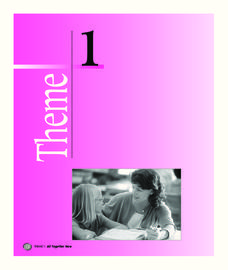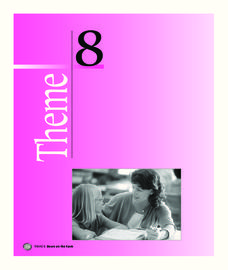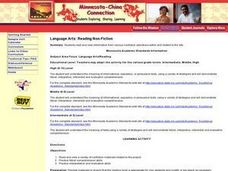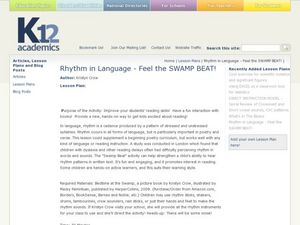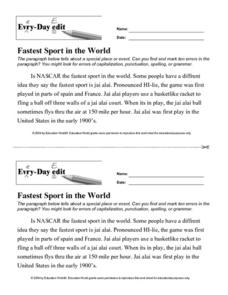Houghton Mifflin Harcourt
All Together Now: Extra Support Lessons (Theme 1)
All Together Now is the theme of this series of extra support lessons. The collection aids the instruction of blending sounds and reading high-frequency words through writing and reading sentences. Support also engages pupils...
Digital History
Representation: By State or by Population
Should representation in the new United States government be based on population? This worksheet illustrates the details of this important quandary through an adaptation of speeches on the topic given at the Constitutional Convention....
Curated OER
Perfect Tenses
As you explore the perfect tenses, direct your class to this resource, which provides explanation and examples for reference as well as an online interactive exercise for practice. They can first read up on haber and either continue...
Curated OER
Using Por and Para
Clear up confusion around por and para. These words can be very difficult, especially for learners who are native English speakers. The information section describes when to use each word and provides examples of specific situations....
Handwriting Without Tears
Handwriting Without Tears
Does learning to write leave your kindergartners in tears? Use these easy and memorable strategies to guide their pencils in the right direction. With cute illustrations and simple instructions, your learners will be writing paragraphs...
Houghton Mifflin Harcourt
Down on the Farm: Extra Support Lessons (Theme 8)
Chants, rhymes, practice pages, picture, word, and punctation cards provide extra support for reading high-frequency words, substituting, blending, segmenting, and identifying phonemes in this Down on the Farm themed unit.
EngageNY
Why Did Douglass Write the Narrative?
Readers take another look at Narrative of the Life of Frederick
Douglass to determine the purpose of the text. They use Frederick Douglass’s Purpose: Text and Questions handout and a close reading guide to direct their thinking. To...
Curated OER
Physical Education Lesson Plan: Fortune Cookies
Students investigate movement. In this physical education lesson, students select a "fortune cookie" made from crumpled paper and read the directions inside. Students perform locomotor skills by following the oral directions...
Curated OER
Holey Story
Sixth graders create a cloze activity based on an article of a current event. They switch worksheets and the next group chooses the words they feel are missing and justify their word choices.
Curated OER
Journey Cake (cooking)
Third graders make journey cakes. In this cooking lesson, 3rd graders read written directions for journey cakes and measure out the ingredients. They cook and discuss the relationship between the cakes and Native Americans.
Curated OER
Language Arts: Inside, Outside, Upside Down
Students create a computer slide show of pictures representing directional words. After listening to several books with examples, they pair words such as inside and outside, below and above, or high and low. With older students or...
Curated OER
Two Step Equations
Sixth graders solve multiple step math problems. In this problem solving lesson, 6th graders practice following step by step instructions such as making cookies or building a snowman. Students use algebra tiles and draw pictures to solve...
Curated OER
The Ghost Catcher
Second graders read the story The Ghost Cather and complete activities related to the book. In this language arts lesson plan, 2nd graders complete comprehension questions, art projects, and more.
Curated OER
Turkey Color Page
Students work on an art project. For this following directions lesson, students must listen carefully and follow the teacher's instructions in order to make a picture of a turkey.
Curated OER
Language Arts: Reading Non-Fiction
Students read and view information sent from seven high school students who travel to China. The daily reports that they send back to the weblog section of the site should be of high interest to students in Minnesota.
Curated OER
Rhythm in Language - Feel the SWAMP BEAT!
Learners explore the rhythm of words. In this reading skills lesson, students read Bedtime at the Swamp and use rhythm instruments to find the cadence in the words of the story. Learners listen for rhythm in other written text as they...
Curated OER
Language Arts: Reading for Information
Sixth graders discover how to turn book titles into questions in order to locate the information during their reading. Using t-charts, they list titles and subtitles with the questions they suggest. Gradually, 6th graders progress from...
Curated OER
The Cleverest Thief
Third graders read the story The Cleverest Thief and complete language art activities to go along with it. Students complete activities including discussion, reading, writing, predicting, drawing, role playing, and sequencing.
Curated OER
Hole Mole
First graders read the story Hole Mole and answer comprehension questions while learning about action words. In this language arts lesson plan, 1st graders read, discuss, and cook, while relating it all back to the story.
Curated OER
Getting to Know You: Lesson Four
Fifth graders practice skills for writing and reading. In this independent reader and writer lesson, 5th graders are given tools to edit their own writing and to choose books they can read on their own. They work both as a class and...
Education World
Every-Day Edit: Longest Road on Earth
In this editing instructional activity, students read a short paragraph on "Longest Road on Earth" and find the ten errors involving capitalization, punctuation, spelling and/or grammar. Students correct each error.
Education World
Every-Day Edit: Fastest Sport in the World
In this proof reading instructional activity, students read a paragraph about Jai Alai, Arguably "The Fastest Sport in the World." Students locate and correct 10 errors in the paragraph.
Education World
Every-Day Edits: Ellis Island
In this proof reading instructional activity, learners read a paragraph about Ellis Island. Students locate and correct 10 errors in the paragraph.
Curated OER
Writing Directions for Mathematical Activities
Fifth graders reorganize comic strips to have them make sense, complete outline and organize their thoughts into outline form to explain directions,
and use that outline to complete their own directions for geometry activities.
